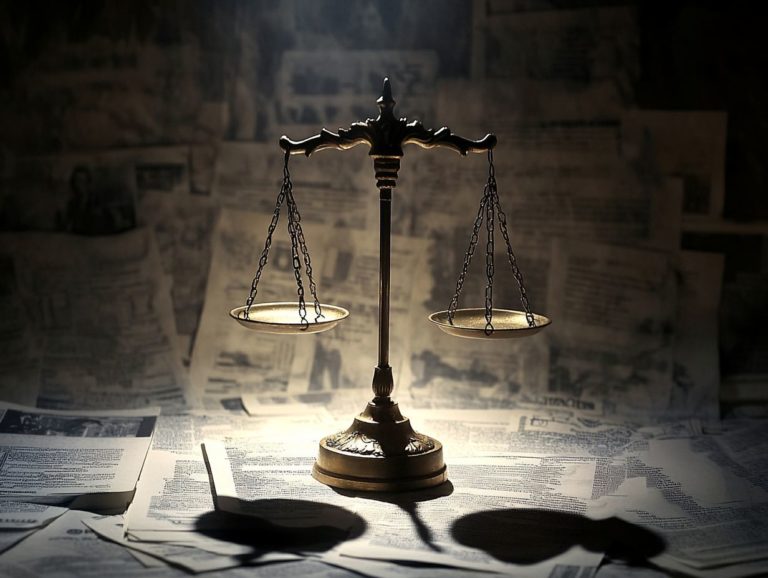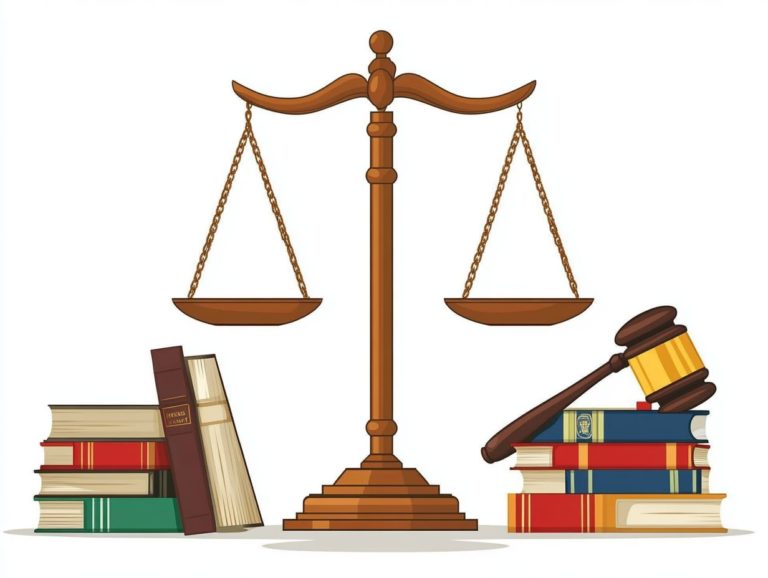The Intersection of IP Litigation and Fair Use
Intellectual property litigation can often feel like navigating a maze, with many laws and terms adding complexity to the process.
At the heart of many of these cases is the concept of fair use. This is a rule that allows you to use someone else’s work in specific ways without asking for permission, as long as you follow certain guidelines about how and why you use it.
Get ready to uncover the essentials of IP lawsuits, define fair use, and examine its significance in court cases through real-world examples.
You ll explore the intricacies and challenges of fair use, enhancing your understanding of this crucial part of laws about creations and inventions.
Join in as you unravel the nuances and implications of fair use in IP litigation.
Contents
- Key Takeaways:
- Understanding IP Litigation
- What is Fair Use?
- The Role of Fair Use in IP Litigation
- Examples of Fair Use in IP Litigation
- Navigating the Grey Areas of Fair Use
- Frequently Asked Questions
- What is the intersection of IP litigation and fair use?
- What is fair use?
- How is fair use determined in IP litigation cases?
- What types of IP litigation cases involve fair use?
- What is the role of the courts in determining fair use in IP litigation cases?
- Are there any exemptions to fair use in IP litigation cases?
Key Takeaways:

IP litigation involves legal disputes over intellectual property rights, such as trademarks, copyrights, and patents.
Fair use is a principle that allows for limited use of copyrighted material without permission for purposes like commentary, criticism, and education.
The intersection of IP litigation and fair use can be complex, with courts examining factors like the purpose of use, the amount used, and the potential market impact on the original work, making it essential to have a grasp on understanding copyright infringement in IP litigation.
Understanding IP Litigation
To understand IP litigation, you need to explore the landscape of laws protecting creations. These include patents, copyrights, trademarks, and trade secrets.
This area of law defends the rights of creators and significantly contributes to economic growth and innovation in the United States.
Disputes in this area often focus on ownership rights, licensing agreements, and the infringement of these intangible assets. It s essential for anyone involved whether an IP lawyer or a business professor to navigate these complexities effectively.
Overview of Intellectual Property Lawsuits
IP lawsuits involve disputes over patent and copyright infringement, along with trademark violations. These are essential for protecting your exclusive rights.
These lawsuits serve as vital mechanisms for safeguarding the economic interests of creators and innovators, helping to foster a vibrant creative economy. For instance, the high-profile case of Apple vs. Samsung highlighted the fierce competition in the tech industry and the far-reaching effects of patent disputes on market positioning.
The legal system plays a key role in resolving these conflicts, ensuring that you, as an inventor or artist, receive recognition and compensation for your work.
The outcomes of these cases can set important precedents that influence future innovations, highlighting the significance of intellectual property as a cornerstone of economic development.
What is Fair Use?
Fair use allows you to use someone else’s work in specific ways without needing permission. This principle supports creative expression while promoting knowledge sharing, striking a balance between ownership rights and public access to creative works.
Defining and Explaining Fair Use

Understanding fair use is crucial in today’s creative landscape. It can be the difference between innovation and infringement!
Fair use hinges on four essential factors that courts consider to determine whether your use of copyrighted material complies with copyright law: the purpose of your use, the nature of the copyrighted work, the amount you use, and the effect on the market for the original work.
These factors create a framework for analyzing each case, ensuring a balanced approach that safeguards copyright protection while allowing for creative expression.
When evaluating the purpose of your use, courts often view new use that adds value favorably where your new work adds significant meaning or a fresh message compared to the original.
A prime example is the Supreme Court’s ruling in Campbell v. Acuff-Rose Music, Inc. Here, the court deemed a rap parody transformative, showing just how vital artistic expression is!
The nature of the copyrighted work can also sway decisions; factual works typically receive more leniency than purely artistic ones.
The amount you use is crucial as well whether you re quoting a small excerpt or a substantial portion. In general, using less tends to favor your case.
Finally, courts scrutinize the impact on the market: if your new work undermines the original’s market value, it may fail to qualify as fair use, as illustrated in Harper & Row v. Nation Enterprises.
The Role of Fair Use in IP Litigation
The role of fair use in intellectual property lawsuits is pivotal, often acting as a robust defense against claims of copyright infringement, particularly in understanding the role of the internet in IP litigation.
It offers a legal safeguard for individuals who incorporate copyrighted material in a manner consistent with the principles of fair use.
This court review can greatly affect the outcome of lawsuits and the enforcement of ownership rights, shaping the landscape of intellectual property law.
How Fair Use is Used in Court Cases
Fair use has been a powerful defense in numerous court cases against copyright claims.
Judges often dive into whether your use qualifies as transformative and respects the legal rights of the original creators.
A landmark case that perfectly illustrates this principle is the 1994 ruling in Campbell v. Acuff-Rose Music, Inc. Here, the Supreme Court delved into whether a parody could be considered fair use.
The court concluded that new use that adds value essentially altering the original work for a different purpose took precedence over any potential harm to the market.
Another noteworthy case is Smith v. Houghton Mifflin Co., where the court sided with a teacher who incorporated excerpts from a textbook into a lesson plan.
The ruling emphasized that educational use could indeed serve broader public interests.
These examples underscore how courts skillfully navigate the fine line between protecting intellectual property rights and encouraging creative expression, shedding light on the ever-evolving landscape of fair use in intellectual property litigation.
Examples of Fair Use in IP Litigation
Examples of fair use in intellectual property litigation reveal the intricate complexities and subtleties of trademark fair use and copyright law.
Through insightful case studies, you can see how new use that adds value and artistic expression have been robustly defended across various legal contexts.
Notable cases illustrate the delicate equilibrium between protecting intellectual property rights and fostering public access to creative works.
Case Studies and Precedents

Case studies and legal precedents surrounding fair use offer valuable insights into how courts tackle the intricacies of copyright law.
They often hone in on whether the new works created are transformative and genuinely enrich the public domain.
The notion of transformative use has undergone significant evolution over the years, culminating in landmark rulings like Campbell v. Acuff-Rose Music, Inc.
This pivotal case emphasized the importance of purpose and character in determining fair use.
The court determined that a parody of a song can serve an entirely different purpose from the original, thereby broadening the understanding of what qualifies for a fair use exemption.
This approach not only encourages creative expression but also presents challenges for copyright holders, who must skillfully navigate the delicate balance between safeguarding their intellectual property and fostering innovation and creativity across various artistic landscapes.
Navigating the grey areas of fair use poses complex issues within copyright law. The boundaries between legal rights and ownership can be ambiguous, resulting in various judicial interpretations during litigation.
This complexity can make it difficult to discern what is permissible. You must carefully assess each situation to ensure compliance and minimize potential legal risks.
Challenges and Considerations
The challenges surrounding fair use in copyright law often hinge on the interpretation of legal rights and the implications for economic interests. There is a pressing need for clarity regarding transformative use.
As you navigate these complexities, you may encounter significant hurdles as a copyright holder or creator. If you aim to produce new works, you might find yourself lost in a legal labyrinth, unsure if your interpretation of ‘transformative use’ will hold up under scrutiny.
Copyright holders also face challenges with potential threats from misuse of their rights. This misuse can hinder creativity and innovation.
It’s crucial to create a framework that both protects rights and encourages the innovation necessary in our rapidly evolving digital landscape. Act now to ensure your creativity isn’t stifled!
Frequently Asked Questions
What is the intersection of IP litigation and fair use?

The intersection of IP litigation and fair use refers to the legal conflicts that arise when someone uses copyrighted material without permission and claims it falls under the protection of fair use.
What is fair use?
Fair use is a principle that lets you use copyrighted material without permission for specific purposes, including commentary, criticism, parody, and news reporting.
How is fair use determined in IP litigation cases?
Courts evaluate fair use by considering four key factors: the purpose of the use, the type of work, how much of it was used, and the impact on the market for the work.
What types of IP litigation cases involve fair use?
IP litigation cases involving fair use can include copyright infringement lawsuits, trademark infringement lawsuits, and patent infringement lawsuits.
What is the role of the courts in determining fair use in IP litigation cases?
The courts play a crucial role in determining fair use by carefully analyzing each of the four factors and making decisions based on the specific details of each case.
Are there any exemptions to fair use in IP litigation cases?
Yes, there are certain exemptions to fair use, such as the first-sale doctrine, which allows the resale of copyrighted material, and the de minimis use doctrine, which permits the use of small or insignificant portions of copyrighted material without permission.






